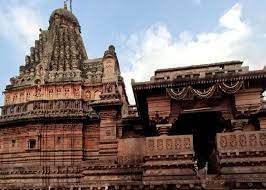UPSC Daily Current Affairs- 12th February 2023 | Current Affairs & Hindu Analysis: Daily, Weekly & Monthly PDF Download
GS-I
Grishneshwar Temple

Context
Recently, Former U.S. Secretary of State Hillary Clinton visited the historic Grishneshwar temple, which is the 12th Jyotirlinga in the country.
About Grishneshwar Temple:
- Grishneshwar Jyotirlinga Temple also known as Ghushmeshwar Temple, is one of the shrines dedicated to Lord Shiva that is referenced in the Shiva Purana.
- This pilgrimage site is located in Ellora (also called Verul), less than a kilometer from Ellora Caves – a UNESCO World Heritage Site in the state of Maharashtra.
- The temple structure was destroyed by the Delhi Sultanate in the 13th and 14th-century.
- It went through several rounds of rebuilding followed by re-destruction during the Mughal-Maratha conflict.
- It was rebuilt in the current form in the 18th century by Ahilyabai Holkar of Indore, after the fall of the Mughal Empire.
- Architectural design of the temple:
- The Grishneshwar temple is an illustration of Maratha temple architectural style and structure.
- It is built of red rocks and is composed of a five-tier shikara.
- This 240 ft x 185 ft temple is the smallest Jyotirlinga temple in India.
- There is a Nandi bull in the court hall.
Source: The Hindu
GSI Discovers Lithium Resources in J&K

Context
The Geological Survey of India has for the first-time established Lithium ‘inferred’ resources(G3) of 5.9 million tonnes in Salal-Haimana area of the UT of Jammu & Kashmir.
What are Inferred Resources?
- The “inferred” mineral resource is a resource for which quantity, grade and mineral content are estimated only with a low level of confidence.
- It is based on information gathered from locations such as outcrops, trenches, pits, workings and drill holes that may be of limited or uncertain quality, and also of lower reliability from geological evidence.
- It is based on the classification from United Nations International Framework Classification for Reserves/Resources – Solid Fuels and Mineral Commodities of 1997 (UNFC-1997).
What is Lithium?
- About:
- Lithium (Li), sometimes also referred as ‘White gold’ due to its high demand for rechargeable batteries, is a soft and silvery-white metal.
- Extraction:
- Lithium can be extracted in different ways, depending on the type of the deposit — generally either through solar evaporation of large brine pools, or from hard-rock extraction of the ore.
- Uses:
- Lithium is an important component of electrochemical cells used in batteries of EVs, Laptops, Mobiles etc.
- It is also used in thermonuclear reactions.
- It is used to make alloys with aluminium and magnesium, improving their strength and making them lighter.
- Magnesium-lithium alloy - for armour plating.
- Aluminum-lithium alloys - in aircraft, bicycle frames and high-speed trains.
- Major Global Lithium Reserves:
- Chile > Australia > Argentina are top countries with Li reserves.
- Lithium Triangle: Chile, Argentina, Bolivia.
- Lithium Reserves in India:
- Preliminary survey showed estimated lithium reserves of 14,100 tonnes in a small patch of land surveyed in Southern Karnataka’s Mandya district.
- Other potential sites:
- Mica belts in Rajasthan, Bihar, Andhra Pradesh.
- Pegmatite belts in Odisha and Chhattisgarh.
- Rann of Kutch in Gujrat.
How India Currently Fulfills its Lithium Demand?
- India is currently dependent on imports for lithium cells and batteries. Over 165 crore lithium batteries are estimated to have been imported into India between FY17 and FY20 at an estimated import bill of upwards of $3.3 billion.
- The country's efforts to secure lithium sourcing agreements are seen as a move against imports from China, which is the major source of both raw materials and cells.
- India is perceived as a late entrant into the lithium value chain, entering at a time when the EV sector is expected to undergo significant disruption.
- 2023 is considered a turning point for battery technology, with the potential for several improvements to the Li-ion technology.
What is the Significance of Discovery?
- Assistance in Achieving Targets:
- India has pledged to reduce its emissions towards net zero by 2070, which requires the availability of lithium as a critical component in electric vehicle (EV) batteries.
- The Central Electricity Authority of India has estimated that the country will need 27 GW of grid-scale battery energy storage systems by 2030, which will require massive amounts of lithium.
- Addressing Global Shortages:
- The World Economic Forum (WEF) has warned of global lithium shortages due to rising demand for EVs and rechargeable batteries, which is estimated to reach 2 billion by 2050.
- The world's supply of lithium is under strain due to the concentration of resources in a few locations with 54% of the world's Lithium reserves are found in Argentina, Bolivia and Chile.
- The International Energy Agency (IEA) predicts that the world could face lithium shortages by 2025.
Source: Indian Express
GS-II
e-Gram SWARAJ

Context
Union rural development and Panchayati raj minister Giriraj Singh recently launched Mission Antyodaya Survey 2022-23, which will shed light on how government schemes have benefited rural India and what is the current economic situation of the country’s villages.
- The survey will be conducted among gram panchayats across the country, all of which have their profiles on E-Gram Swaraj portal.
About E-Gram SWARAJ:
- It is one single interface on which the details will be listed panchayat wise.
- The platform will provide records of work from planning to the implementation in every village panchayat under Gram Panchayati Development Plan (GPDP).
- All the details related to Panchayat Sachiv and Panch can be viewed on Gram Swaraj Portal.
- The works of the Ministry of Panchayati Raj will be accessible through Gram Swaraj Portal.
- The Gram Swaraj Portal and application will provide a boost in transparency by decentralized planning of development projects, with progress reports updates and increased accountability.
- Anybody can create an account on the Gram Swaraj Portal and know about the developmental works of villages.
Source: Economic Times
Crony Capitalism

Context
Parliament witnessed sharp exchanges over the Adani-Hindenburg issue and the opposition is accusing it of crony capitalism and raising demands for a probe by a Joint Parliamentary Committee or a Chief Justice of India (CJI)-designated committee.
What is Crony Capitalism?
- About:
- Crony capitalism is a term used to describe a capitalist economic system in which individuals or businesses with close ties to political leaders and government officials use their political connections to gain an unfair advantage in the marketplace.
- In the Crony Capitalism Index 2021 published by The Economist; India was ranked at 7th position where crony sector wealth accounted for 8% of Gross Domestic Product (GDP) of the country.
- Issues Associated with Crony Capitalism:
- Unfair Advantage in Marketplace: Crony capitalism can lead to corruption as businesses use their political connections to gain an unfair advantage in the marketplace, often by bribing government officials.
- This can undermine the rule of law and erode public trust in government institutions.
- Distorted Market Competition: When some businesses are given an unfair advantage through their political connections, it distorts market competition and makes it difficult for smaller businesses and entrepreneurs to succeed.
- This can lead to a concentration of wealth and power in the hands of a few individuals or corporations.
- Reduced Innovation: The dominant position of large businesses often erodes competition and discourages them to further innovate or improvise their products/services.
- This can stifle innovation in the overall economy and lead to a decline in competitiveness.
- Public Distrust of Government and the Economy: Widespread crony capitalism can lead to a loss of public trust in government institutions and the economic system.
- This can make it difficult for policymakers to implement reforms and for businesses to operate effectively.
- Unfair Advantage in Marketplace: Crony capitalism can lead to corruption as businesses use their political connections to gain an unfair advantage in the marketplace, often by bribing government officials.
How can India Address the Issues Related to Crony Capitalism?
- Improving Transparency and Accountability: India can improve transparency and accountability in its political and economic systems by implementing measures such as open data initiatives, increasing the independence of regulatory agencies, and improving the transparency of government contracts and subsidies.
- Encouraging Competition: India can encourage competition by reducing barriers to entry for smaller businesses and entrepreneurs, such as reducing red tape and streamlining regulations.
- This can make it easier for new entrants to compete with established businesses and reduce the concentration of wealth and power in the hands of a few individuals or corporations.
- Towards Corporate Ethical Responsibility: India can promote responsible business practices by implementing measures to ensure that businesses act ethically and sustainably, in lines of corporate social responsibility and sustainability initiatives.
- This can increase public trust in the economic system and encourage businesses to act in the best interests of society as a whole.
- Encouraging Responsible Political Behaviour: India can encourage responsible political behaviour by increasing the transparency of political donations and lobbying activities.
- This can reduce the potential for corruption and ensure that elected officials are held accountable for their actions.
Source: The Hindu
GS-III
The Role of Labour Unions/Trade Unions in Emerging Sectors

Context
There have been many reports of layoffs in the last few months, especially in emerging sectors.
- Lay-offs have been taking place not only in India but in major economies like the U.S. too. Large, medium and small enterprises as well as start-ups have let go of dozens or even thousands of workers.
About Labour Union/Trade Union:
History of Trade Union Movement in India
- In 1870, the first labour organization Working Men’s Club was founded in Calcutta by Sasipada Banerjee. He also published in the journal ‘Bharat Sramajibi‘.
- In 1875, Sorabjee Sharpoorji Bengalee of Mumbai organized the labour agitation in Bombay against the appalling conditions of workers, especially women and children.
- Thus, the first organized labour agitation was organised by S. Bengalee.
- It results in the formation of the first factory commission in the country in 1875.
- In 1875, Narayan Meghaji Lokhande was the first to represent the grievances of the Indian working class before the Labour Commission of Bombay.
- In 1890, M Lokhande set up the first association of Indian workers the ‘Bombay Mill-Hands Association‘ in Bombay.
- In 1897, the Amalgamated Society of Railway Servants of India was established.
- In 1920, the All Indian Trade Union Congress (AITUC), the first trade union on an All-Indian basis, was formed.
- The four founder fathers of AITUC were Lala Lajpat Rai, N. M. Joshi, Joseph Baptista, and Diwan Chaman Lal.
- In 1926, British Government in India passed the Trade Union Act of 1926, which was the first labour enactment to legalize the formation of the Labour Union in India.
- In 1928, Girni Kamgar Union organized the Bombay Textile Mills strike under the communists.
- In 1947, Indian National Trade Union Congress (INTUC) was formed as the labour wing of the Indian National Congress (INC) with the efforts of Sardar Vallabbhai Patel and Gulzarilal Nanda.
- In December 1948, the Indian Federation of Labour (IFL) merged with Hind Mazdoor Sabha (HMS) and formed United Trade Union Congress (UTUC).
- In 1955, Jan Sangh (now Bhartiya Janta Party) also established its labour wing known as Bharatiya Mazdoor Sangh (BMS), founded by Dattopanti Thengdi.
- In 1970, the Centre of Indian Trade Union (CITU), affiliated with the Communist Party of India (Marxist), was formed with T. Ranadive as its first president.
Major reasons for the lay-offs:
- Impact of COVID-19 pandemic
- Changes in business strategy
- Automation and technology advancements
- Re-evaluation of company goals and priorities
- Mergers and acquisitions
- Financial difficulties
- Frequent changes in government policies and regulations
- Decreased investment
- Decreased demand for goods and services
- Increased competition
The Amazon story:
Labour Union in Amazon:
- Amazon workers at the warehouse at Staten Island called JFK8 succeeded in forming the Amazon Labour Union.
- Amazon reacted by filing numerous objections with the National Labour Relations Board, the federal body that protects the rights of private sector employees to join together.
- On the other hand, employees at the warehouse near Albany voted overwhelmingly against unionisation in October 2022 as many of them were sceptical of the bargaining power of a union vis-à-vis a giant like Amazon.
In India:
- Amazon shut down Amazon Food and Amazon Academy.
- It retrenched workers in the Indian facility in a gradual manner.
- The Deputy Chief Labour Commissioner in Bengaluru served a notice seeking information from the company.
- But it is well-known how seriously employers, especially multi-national corporations (MNCs), take labour departments; they ignore conciliation meetings more often than trade unions.
Importance of Labour Unions in Emerging Sectors:
- Job Security and Protection against Mass Lay-offs:
- Labour unions play an important role in advocating for job security and protecting workers against mass layoffs, particularly in emerging sectors where layoffs may be more widespread.
- Support for Re-employment and Career Development:
- Labour unions can provide support and resources for re-employment and career development for workers who have been laid off, helping them to find new job opportunities and secure their financial future.
- Negotiation of Severance Packages:
- Labour unions can negotiate with employers to provide adequate severance packages for workers affected by mass lay-offs, helping to mitigate the financial impact of job loss.
- Collective Bargaining Power:
- By pooling their resources and bargaining power, labour unions can negotiate with employers to secure better wages, benefits, and working conditions for workers, making them less vulnerable to layoffs and more able to secure their financial future.
- Advocacy for Workers’ Rights and Protections:
- Labour unions can use their voice and influence to advocate for workers’ rights and protections against mass lay-offs, working to prevent layoffs and ensure that workers are treated fairly and equitably.
Landmark Cases About Trade Unions In India
All India Bank Employees’ Association v. N.I.Tribunal
- The case laid down the rights of members of trade unions that are covered under the fundamental right to freedom of expression and speech under Article 19(1) (c).
- However, the court ruled that Article 19(1) (c) does not include a right to achieving all the goals for which the trade union was created.
- The ruling also ruled that adequate industrial legislation can govern or restrict trade union strikes.
Balmer Lawrie Workers’ Union, Bombay and Anr. v. Balmer Lawrie & Co. Ltd. and Ors
- The SC’s underlying assumption was that a recognised union represents all workers in a particular industrial project or industry. In the MRF United Workers case, this matter was also mentioned.
Kalindi and Others v. Tata Locomotive and Engineering Co. Ltd
- The Supreme Court concluded that there is no right to representation unless it recognises it through its standing orders.
- In Bharat Petroleum Corporation Ltd. v. Maharashtra General Kamgar Union and Others, the decision was upheld.
Way Forward:
- Labour unions play a crucial role in emerging sectors by advocating for the rights and interests of workers.
- In industries such as technology and renewable energy, where working conditions and job security may be uncertain, unions provide a voice for employees and negotiate fair wages, benefits, and working conditions.
- Historically, the role of trade unions in India was mostly limited to collective bargaining for economic reasons.
- On the other hand, trade unions currently play an important role in employee welfare, cultural programmes, banking, and medical facilities, as well as raising awareness through training and education of trade union members.
- Despite a few recent events that can mainly be classified as one-off situations, most trade unions have succeeded to create a climate that allows for a constructive conversation between workers and employers about whatever requests they may have.
- Furthermore, Indian trade unions have ensured that a forum exists to support better industrial relations, industrial growth, and productivity improvement over time.
Source: The Hindu
Vivad se Vishwas II scheme

Context
The Budget has proposed the Vivad se Vishwas-2 scheme to settle long-pending litigation in cases where an arbitration order has been challenged in any Indian court.
About Vivad se Vishwas II scheme:
- The Vivad Se Vishwas scheme was announced under Union Budget 2020 to reduce ongoing legal disputes under direct taxation.
- It is a “one-time settlement” scheme that contains a draft pact between the litigating parties to bring finality to the dispute.
- It is proposed to be implemented through a functionality on the Government e-Marketplace (GeM) portal.
- Under this scheme, the interest and penalty associated with the disputed tax amount is completely waived off.
- As a result, the taxpayer has to pay only the amount of disputed tax.
Conditions for the one time settlement under the scheme:
- no state government or any other private firm is party to the case, or
- The dispute pertains to pending financial claims, and not any performance claims.
Eligibility:
- Companies or entities in domestic contractual disputes with the central government and associated bodies only can seek to settle pending matters under the ‘Vivad se Vishwas II’ scheme.
- The scheme would apply to disputes where one of the parties is either the Centre, its autonomous bodies, public sector banks, financial institutions and enterprises, Union Territories, including Delhi, and their agencies, and organisations where the Centre has a stake of 50 per cent, like metro rail corporations.
- Disputes, where claims are raised against procuring entities as above along with some other party (state government or private party), shall not be eligible under the scheme.
- Disputes having only financial claims against the procuring entities will be settled through this scheme.
- The scheme proposes graded settlement terms depending on the pendency level of the dispute and it is proposed to cover only cases involving domestic arbitration and cases under international arbitration are not eligible to be settled under this scheme.
Source: Business Standard
Quasicrystals

Context
Scientists have discovered a third natural source of quasicrystals, extending the latter’s reputation for violent origins.
About Quasicrystals:
- Quasicrystal, also called quasi-periodic crystal, matter formed atomically in a manner somewhere between the amorphous solids of glasses and the precise pattern of crystals.
- In quasicrystals, the atoms are arranged in a pattern that repeats itself at irregular, yet predictable, intervals.
- The American-Israeli scientist Dan Shechtman discovered quasicrystals in the lab in 1982.
- The first natural quasicrystal found was as microscopic grains in a fragment of the Khatyrka meteorite lying in the Koryak mountains of Russia.
- The second time scientists found natural quasicrystals in the remains of the Trinity test of the Manhattan Project.
- Recently in the Sand Hills dunes in northern Nebraska, where scientists found silicate glass which is a dodecagonal quasicrystal, rare even for quasicrystals.
- Three varieties: icosahedrite, decagonite and proxidecagonite.
- Proxidecagonite is also known as quasicrystal approximant.
- Icosahedrite’s crystal structure exhibited fivefold symmetry in two dimensions where the pattern repeated itself after being rotated by 72º.
- Icosahedrite exhibited 20-fold symmetry in three dimensions.
- Decagonite exhibited 10-fold symmetry by 36º
- They inhibit properties like electrical properties, optical properties, thermal properties, hardness, anticorrosive properties and hydrogen absorption properties.
Source: The Hindu
|
38 videos|5288 docs|1117 tests
|
FAQs on UPSC Daily Current Affairs- 12th February 2023 - Current Affairs & Hindu Analysis: Daily, Weekly & Monthly
| 1. What are the important topics covered in GS-I for the UPSC exam? |  |
| 2. What is the significance of GS-II in the UPSC exam? |  |
| 3. What are the key areas covered in GS-III for the UPSC exam? |  |
| 4. How can I prepare effectively for GS-I in the UPSC exam? |  |
| 5. What resources can I refer to for GS-II preparation for the UPSC exam? |  |





















